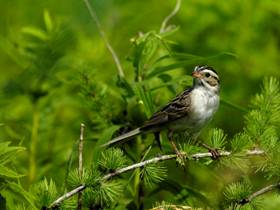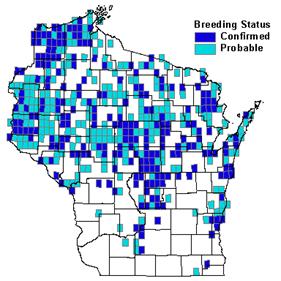

Status/Protection
- Global Rank: G5 Key to global and state ranks
- State Rank: S4B
- WBCI Priority: PIF
Population Information
The Federal BBS information can be obtained at http://www.mbr-pwrc.usgs.gov/bbs/bbs.html by clicking on Trend Estimates and selecting the species in question. All estimates are for time period (1966-2005).
- Federal Breeding Bird Survey: significant decline
- Federal Breeding Bird Survey (WI): significant decline
- Federal Breeding Bird Survey (BCR 23): non-significant decline
- Federal Breeding Bird Survey (BCR 12): non-significant decline
- Chequamegon National Forest Bird Survey (NRRI): non-significant decline (1992-2005)
- WSO Checklist Project: significantly increasing (1983-2007)
Life History
- Breeding Range: Eastern British Columbia across southern Canada and northern Great Plains to southern Ontario (Knapton 1994).
- Breeding Habitat: Pine Barrens, Idle Cool-season Grasses, Pasture, Grassland-shrub, Sand Barrens, Dry Prairie, young conifer plantations.
- Nest: Shrub.
- Nesting Dates: June-July.
- Foraging: Ground glean.
- Migrant Status: short-distance migrant.
- Habitat use during Migration: edges of fields, woods, roads, and streams.
- Arrival Dates: early May.
- Departure Dates: August-September.
- Winter Range: Southern Texas and Mexico.
- Winter Habitat: deserts and upland plains.
Habitat Selection
Clay-colored Sparrow prefer habitats with scattered or locally dense shrubs in an idle grassland context such as Grassland-shrubs, shrubby wet old fields, open and brush barrens, clear-cut, recently burned areas and young pine plantations. Low shrubs (scrub oak, young oaks, hazel, etc.) are required for nesting. They don’t seem to specialize on any one species of shrub/tree. Clay-colored Sparrows prefer grasslands with medium height density (15-35 cm), high litter layer, even ratio of forbs to grass and shrubs covering 5-30% of ground (Sample and Mossman 1997). They are also common in pastures, idle grasslands, and old fields when there is adequate shrub content for nesting. Clay-colored Sparrow can be found in areas smaller than 25 acres (Sample and Mossman 1997) and are more tolerant of woody edges and people than many grassland birds (Knapton 1994). In managed Pine Barrens and recent clearcuts in Northwestern Wisconsin, nest success was positively associated with the amount of green vegetation immediately surrounding the nest (Ryba 2002).
Habitat Availability
Clay-colored Sparrow are one of the most abundant breeding birds in early successional pine and oak barrens, clearcuts on dry soil types, and grasslands with scattered shrubs. Large acreages of suitable open barrens habitat exists within the Northwest Sands and Northeast Sands ecological landscapes mainly on managed areas like Crex Meadows Wildlife Area, Fish Lake Wildlife Area, Spread Eagle Barrens and other properties managed for Sharp-tailed Grouse. Clay-colored Sparrows are often the most abundant breeding bird on these sites (Ryba 2002, Mossman et al. 1991). Clay-colored Sparrow are also quite abundant on the Central Sand Plains, Central Sand Hills, and Western Prairie ecological landscapes on large and small managed grasslands that have some woody component. Open barrens, shrubby wet old fields, Grassland-shrub and other successional types used by Clay-colored Sparrow are vulnerable to succession if not maintained with some form of disturbance. Clear-cuts or burned areas and young conifer plantations are potentially important source habitats (Ryba 2002) and could be incorporated into a large open barrens habitat restoration project that would temporarily create suitable habitat within a larger landscape (Sample and Mossman 1997).
Population Concerns
Conversion of shrub-grassland communities to agriculture, development or forest is a major factor in overall population size (Knapton 1994). CCSP was once much more common in the southern 1/3 of the state, but now is found in limited areas where grass-shrub communities persist. CCSP is still common in the northern 2/3 of Wisconsin where suitable habitat exists (Robbins 1991). The persistent loss of barrens and conversion of Jack Pine forests to Red Pine will continue to limit available habitat. CCSP is one of many grassland birds suffering from persistent habitat declines across their range.
Recommended Management
Managing for Clay-colored Sparrow and other grass/shrub birds requires maintaining scattered patches of shrubs within an open grassland or barrens landscape. Disturbance regimes should be longer for this and other grass-shrub species (DeChant et al. 2003) or managers should be careful to leave patches of shrubs after burns or mowing. Clear-cut harvest units can be arranged adjacent to other grassland/barrens openings to increase their effective size. Conifer plantations should not be placed within open grassland habitats because they will become an unsuitable edge when the trees grow over 10 feet (Sample and Mossman 1997). In areas where Sharp-tailed Grouse are intensively managed for Clay-colored Sparrow seem to respond well (Ryba 2002, Sample and Mossman 1997, Knapton 1994).
Research Needs
The significant and consistent declines of breeding populations should be investigated further to determine underlying causes, and to determine if range contraction is accompanying the decline (Knapton 1994) . Research and monitoring are needed to help evaluate grassland/shrubland restorations to inform management geared at improving habitat for this, and other, species.
Information Sources
- David Sample, Grassland Community Ecologist, Wisconsin DNR Research Center, 1350 Femrite Dr., Monona, WI 53716. 608-221-6351.
- Knutson, M. G., G. Butcher, J. Fitzgerald, and J. Shieldcastle. 2001. Partners in Flight Bird Conservation Plan for The Upper Great Lakes Plain Physiographic Area 16). USGS Upper Midwest Environmental Sciences Center in cooperation with Partners in Flight. La Crosse, Wisconsin.
- North American Breeding Bird Survey: http://www.npwrc.usgs.gov
- Wisconsin Breeding Bird Atlas: http://www.uwgb.edu/birds/wbba/
- Effects of Management Practices on Grassland Birds: Clay-colored Sparrow
References
- Dechant, J. A., M. L. Sondreal, D. H. Johnson, L. D. Igl, C. M. Goldade, M. P. Nenneman, and B. R. Euliss. 2003. Effects of management practices on grassland birds: Clay-colored Sparrow. Northern Prairie Wildlife Research Center, Jamestown, ND. Northern Prairie Wildlife Research Center Online. http://www.npwrc.usgs.gov/resource/literatr/grasbird/ccsp/ccsp.htm (Version 12AUG2004).
- Knapton, R. W. 1994. Clay-colored Sparrow (Spizella pallida). In the Birds of North America, No. 120 (A. Poole and F. Gill eds.). Philadelphia: The Academy of Natural Sciences; Washington, D. C.: The American Ornithologists’ Union.
- Mossman, M.J., R.M. Hoffman, and E. Epstein. 1991. Birds of Wisconsin Pine and Oak Barrens. Passenger Pigeon 53: 137-163.
- Robbins, S. D., Jr. 1991. Wisconsin Birdlife: Population and distribution past and present. Madison, WI: Univ. Wisconsin Press.
- Ryba, A. J. 2002. Songbird Nesting Ecology in the Pine Barrens of Northwestern Wisconsin. M.S. Thesis. University of Wisconsin Steven’s Point. 52 pages.
- Sample, D. and M. Mossman. 1997 Managing Habitat for Grassland Birds: A Guide for Wisconsin. Wisconsin Department of Natural Resources: Madison, WI.
- Temple , S. A. 2002. Dickcissel (Spiza americana). In the Birds of North America, No. 703 (A. Poole and F. Gill eds.). The Birds of North America, Inc., Philadelphia, PA.
- Temple S. A., J. R. Cary, and R. Rolley. 1997. Wisconsin Birds; A Seasonal and Geographical Guide. Wisconsin Society of Ornithology and Wisconsin Department of Natural Resources, Madison, WI.
Contact Information
Compiler: Jenny Herrmann, mherrmann4@wi.rr.com
